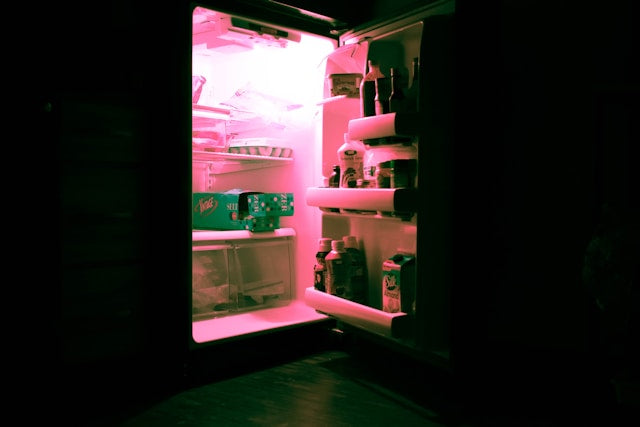Mini fridges come in a variety of sizes, usually ranging from 1.7 cubic feet up to 4.5 cubic feet. Normally, a mini fridge uses 50-180 watts. The wattage used by a mini fridge depends on its size:
-
A 1.7 cubic foot mini fridge generally uses between 50 to 80 watts. This translates to around 1-2 kWh of electricity usage per day.
-
A mid-sized 3.2 cubic foot mini fridge often uses about 90 to 120 watts. This equals around 2-3 kWh of electricity usage per day.
-
Larger 4.5 cubic foot mini fridges can use 140 to 180 watts or more. They may consume 3-4 kWh of electricity per day.
Several factors affect how much electricity a specific mini fridge will use:
-
Temperature setting - A colder setting requires more power to maintain.
-
Age of the unit - Older models tend to be less energy efficient.
-
Usage patterns - Frequent opening of the door lets out cold air and makes the fridge work harder.
-
Ambient temperature - Hotter environments tax the fridge more for cooling.
-
Fullness - A full fridge uses less power than an empty one.
So when estimating your mini fridge's electricity usage, be sure to account for its size, settings, usage and environment. Monitoring your actual consumption with a kWh meter can also help narrow down your particular fridge's energy appetite.

Calculating Your Mini Fridge's Electricity Use
To calculate how many watts your specific mini fridge uses, first look at the product specs or manual to find the wattage rating. This will be listed in watts or kilowatts.
Next, use the wattage rating to calculate the kilowatt-hours (kWh) used, which is the unit most electricity bills are based on. Simply multiply the wattage by the number of hours the fridge is turned on per day.
For example, a mini fridge that runs continuously using 80 watts would use:
80 watts x 24 hours = 1,920 watt-hours per day
1,920 watt-hours / 1000 = 1.92 kWh per day
To estimate the cost, take the kWh per day and multiply by your local electricity rate. For example, at $0.12 per kWh:
1.92 kWh x $0.12 per kWh = $0.23 per day
For the entire month that would be about $0.23 x 30 days = $6.90
There are also handy online electricity usage calculators you can use. Just input your mini fridge's wattage rating and how many hours per day it runs and it will provide estimates of the kWh usage and monthly costs.
Knowing the wattage and estimated electricity cost can help you decide if it's worth upgrading to a more energy efficient model or using supplemental power sources.

Tips for Reducing Mini Fridge Energy Use
There are several easy ways to reduce the amount of electricity your mini fridge uses, saving you money on energy costs:
Regularly clean the coils - Dust buildup on the condenser coils can reduce their heat transfer efficiency. Clean them every 6 months with a vacuum or brush to maintain optimal performance.
Get an EnergyStar certified model - EnergyStar certification means the unit meets strict energy efficiency guidelines set by the EPA. Choose an EnergyStar mini fridge to cut electricity usage by up to 30%.
Ensure proper door sealing - If the door seal is damaged or not sealing properly, cold air can leak out causing the fridge to work harder. Replace worn seals for maximum insulation.
Locate away from heat sources - Position the mini fridge away from heat sources like ovens, dishwashers or heating vents. The less it gets warmed, the less electricity it will use.
Adjust the temperature setting - Set to the warmest acceptable temperature for your needs. The colder you set it, the more energy it requires to maintain that temperature.
Using a Portable Power Station
A portable power station like the Growatt INFINITY 1500 is an excellent way to keep your mini fridge running during power outages. This type of backup power supply provides many key benefits:
-
Reliable power on-the-go. With a 2000W pure sine wave inverter, the INFINITY 1500 has more than enough capacity to handle the electricity needs of a typical mini fridge. Even better, it can power multiple devices at the same time so you can run other essentials like lights, phones, and laptops.
-
Solar rechargeable. The INFINITY 1500 features solar input allowing it to be recharged by solar panels. This means you can stay powered up using just the sun, reducing dependence on fuels. The 1512Wh capacity means quick solar recharging in just 2-2.5 hours.
-
Multiple outlets. This unit has a diverse range of outlets including AC, USB-A, USB-C PD 100W, DC, and more. There are plugs suitable for directly running your mini fridge. The LCD display lets you monitor power consumption.
-
Compact and portable. Weighing only 36.4 lbs, the INFINITY 1500 is designed with a handy telescoping handle and wheels making it easy to maneuver. The compact size is perfect for using in RVs, campers, emergency kits, and more.

With its ample power capacity, solar charging capabilities, and AC outlets, the Growatt INFINITY 1500 is ideal for keeping a mini fridge or other small appliances powered during grid outages. Investing in a portable power station provides reliable backup electricity whenever you need it.
Monitoring Mini Fridge Electricity Costs
Knowing how much electricity your mini fridge uses is key to monitoring the costs and adjusting your usage. Using a simple plugin kilowatt meter can provide real-time data on your mini fridge's power draw.
To use a kilowatt meter:
-
Plug the meter into an outlet, then plug the mini fridge into the meter.
-
Check the meter display to see the real-time power draw in watts or kilowatts.
-
Record the wattage periodically to get an average wattage used over time.
-
Calculate the kilowatt-hours (kWh) used per day by dividing the average watts by 1000 and multiplying by the number of hours per day the fridge runs.
-
Multiply the daily kWh usage by your local electricity rate to estimate the daily electricity cost.
Monitoring your mini fridge's electricity usage with a kilowatt meter helps identify times of peak draw and opportunities to adjust your usage. For example, opening the door frequently or keeping the temperature too cold will increase energy use. Being mindful of these habits and adjusting as needed based on meter readings can reduce your mini fridge's impact on your electricity bill. Overuse leading to much higher than expected costs is avoidable with periodic monitoring and adjustment.
Final Considerations
Mini fridges provide convenient refrigeration for dorm rooms, offices, basements, garages, and more. But their constant electricity draw can impact your energy bills over time. By understanding typical power usage, implementing efficiency tips, and monitoring consumption, you can keep costs down.
Consider the following takeaways when using a mini fridge:
- Calculate the wattage of your specific model and how many kWh it uses per day. Higher efficiency EnergyStar models use less.
- Regularly clean coils, maintain proper clearance, and use fridge without overloading to maximize efficiency.
- Look for options to reduce usage like timers, temperature setting, and hibernation modes when not needed.
- Use a portable power station as backup for power outages to avoid food spoilage. Solar generators offer renewable energy.
- Check energy bills to see overall household usage and the impact of the mini fridge.
- Invest in a higher efficiency or appropriately sized unit if costs are too high.
With some planning and awareness around electricity consumption, a mini fridge can provide handy refrigeration without breaking the bank. Take steps to use energy responsibly and have a backup power supply for essential appliances.
FAQs on Mini Fridge Electricity Usage
When it comes to electricity usage, mini fridges have some key differences from their full-sized counterparts. Here are answers to some of the most frequently asked questions.
How energy efficient are mini fridges compared to full size refrigerators?
Mini fridges are generally more energy efficient than full size models. A typical full size fridge uses 500-800 watts, while a mini fridge can use as little as 55 watts. The smaller size and capacity of a mini fridge means it doesn't have to work as hard to stay cool. Just don't expect a mini fridge to be as efficient as a top of the line full sized EnergyStar model.
How much will a mini fridge add to my electricity bill?
This depends on the wattage rating and how many hours per day you use it. As an example, a 55 watt mini fridge running 24 hours a day would add about 48 kWh to your monthly usage, costing $5-10 on average. A less efficient 120 watt model running 12 hours a day would use about 52 kWh, costing around $5-15 per month depending on your electricity rate.
What factors affect a mini fridge's electricity usage?
The environment around the mini fridge, how full it is, and how often the door is opened all impact energy use. Setting the temperature colder than needed, having it in a hot garage, and over-stuffing it forces the compressor to work harder. Get in the habit of not leaving the door open longer than necessary.
Can I run multiple mini fridges without skyrocketing my electricity bill?
It depends on your existing usage, electricity costs in your area, and how you use the appliances. For example, three compact 55 watt mini fridges running 24/7 would add about 130 kWh to your monthly usage, increasing a typical bill by $15-30. If your mini fridges don't need to run all day, you can reduce costs by powering them down when not in use. Monitor your electric bill to identify any spikes after adding new mini fridges.






